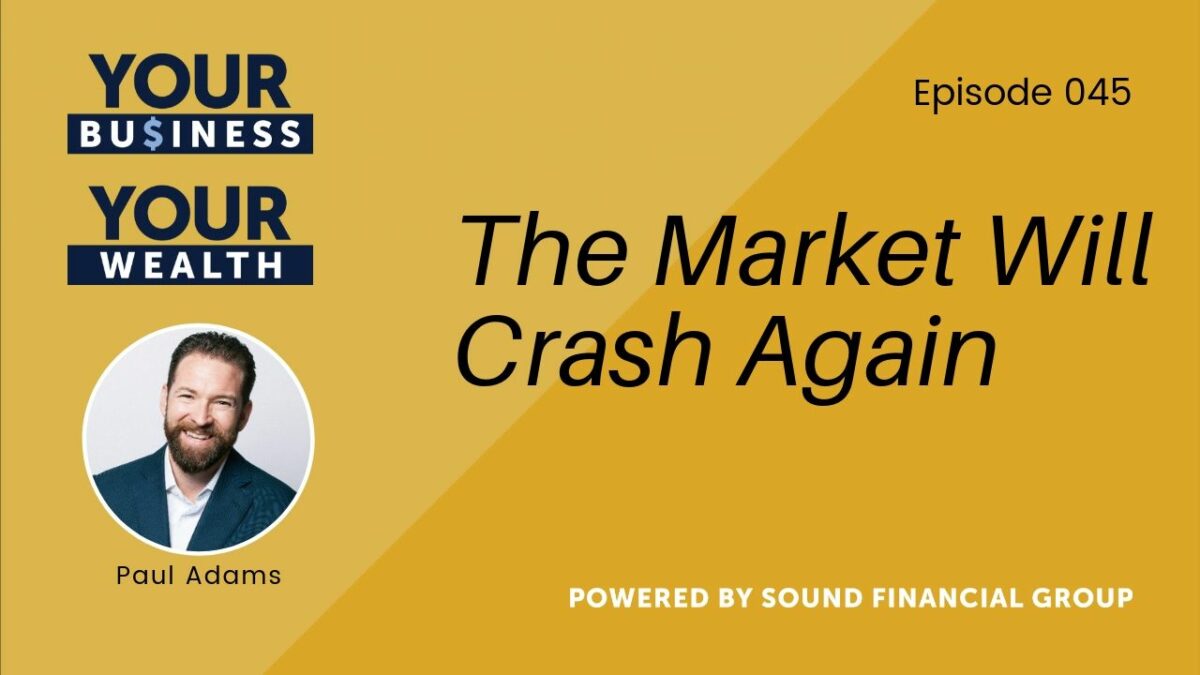Podcast Episode 45: The Market will Crash Again
EPISODE SUMMARY
Paul discusses what happens when a market crashes, and how you can leverage it to your benefit. It is in the financial institution’s personal interest to keep you worried and believing that the sky is falling. They are constantly providing ‘shocking’ points to keep your eyeballs glued to the screen. Paul asks that you don’t fall for it. Focus on the facts, not the fears, in front of you, and you will come out ahead.
WHAT WAS COVERED
- 01:50 – We often don’t understand why the markets are going up and down.
- 02:05 – Is the sky falling? According to the media, yes.
- 05:30 – Will the stock market crash in 2016?
- 06:00 – Those who are telling us the sky is falling all have an interest in trying to get your attention.
- 11:20 – Let’s talk history. How many market crashes have really happened?
- 13:35 – Paul walks you through a couple of hypothetical scenarios of what happens to an average investment portfolio during a market crash.
- 14:05 – Let’s assume there will be another market crash in the future. We just don’t know when yet.
- 19:25 – Through examples of history, there’s a good chance your portfolio won’t be affected long-term when there’s a market crash.
- 21:45 – If you broke strategy during a market crash, you would have taken a loss.
- 23:15 – History says market crashes do recover.
- 24:15 – Don’t abandon strategy when things become uncertain.
TWEETABLES
“We need to support you because the sky is falling”
“Volatility is the reason we are rewarded as owners of equities and stocks.”
“There’s going to be another market crash. We don’t know when, but it’s coming.”
SHARE THE SHOW
Did you enjoy the show? We would love it if you subscribed today and left us a 5-star review!
- Click this link – Sound Financial Bites
- Click on the ‘Subscribe’ button below the artwork
- Go to the ‘Ratings and Reviews’ section
- Click on ‘Write a Review’
RELATED LINKS
MUSIC CREDITS
“Legends Are Made” Copyright 2017. Music, arrangement and lyrics by Sam Tinnesz, Savage Youth Music Publishing SESAC and Matt Bronleewe, UNSECRET Songs SESAC
EPISODE TRANSCRIPT – FORMATTED PDF
EPISODE TRANSCRIPT – ORIGINAL TEXT
Hello, Paul Adams here. Welcome to Sound Financial Bites, where we help you with bite-sized pieces of financial and life knowledge to help you design and build a good life.
Hello, and welcome to Sound Financial Bites. This is Paul Adams, your host for today’s podcast, as well as the president for Sound Financial Group. Now, normally in this part of the podcast is where I talk about our different types of podcast, etcetera. I’m scrapping all of that. I think you all know, as listeners, that if there’s anything we can do to serve you, you can get ahold of me for a 15-minute phone call. Just email “Initial Conversation” in the subject line to [email protected]. That’s Sound Financial Group, SFG, WA like Washington dot com. We’ll do our best to dig in and engage with you and see what we can do to help and support you. I may not be the right advisor. One of our advisors might be a better fit, or maybe it’s not us at all because there’s something that you care about in life that doesn’t match with us, or vice-versa, but we’re always happy to have that first conversation. At least leave with a new relationship even if we don’t end up working together.
Let’s throw that aside. I am recording this podcast today because I just really felt it on my heart that all of you are going to need support here shortly. So, I’m hoping this podcast is one that some of you will go back and listen to on a consistent ongoing basis that what you’re going to be able to do is point other people to this podcast. Because, there’s all kinds of misinterpretations that people have about money, what’s going on with the markets as they go up and down. The problem is that we often don’t understand why they’re going up and down, and we don’t understand what’s happening or is the whole world falling apart. What hit me is we need to support you because the sky is falling. It is absolutely falling. It’s constantly falling. Just ask somebody. The sky is falling. You’ll never be okay again financially because of how bad the market is.
Now, how we know that that’s true that the market’s going to fall apart, that you’re going to be decimated is because everybody says so. Everybody says so. Every news outlet, when some blip in the market occurs, I don’t know if you remember the entire Brexit fiasco where it was going to destroy Europe, and it lasted two weeks. You know, we literally had clients, a few of them, that are just coming on board now who, when Brexit happened, they said, “We tried to get money in the market and we couldn’t do it fast enough because it bounced back that quickly.” That is the way the market works. We can’t predict what’s going to happen, and there are so many people out there. You guys have heard me talk about the idea that there’s all kinds of organizations out there that are after us to capture our spending, right? The car companies are brilliant. You have the consumption of why you should go to dinner or buy a bigger house. Whatever the thing is, a really cool watch, and why you should spend money in those places.
Here’s the thing. If you think those people are good, you should look at the financial marketers. The financial marketers, and I don’t just mean financial institutions, but some of the business channels, the news channels, all of them are trying to be able to get our attention because they need our eyes wrapped on the screen, they need us to not change the channel, and they need us to make it through the commercial break.
That’s why they need our rapt attention. They’re selling our eyes. We are not their customer. If you’re viewing a radio show, if you’re viewing a TV show about money, you are not their customer. The advertisers are their customer. Get real straight on that. The advertisers are the customers of that radio show host you like to listen to on money. The advertisers are the customers of the TV news channel.
“So, wait a second, Paul. Okay, I accept that, that their customers are the advertisers, because the advertisers are what pays the bills. I don’t send any money to the news stations. So, if they’re the customers, who am I?” Well, this is the part that’s a little hard to sit with. You’re the product. Your eyes on that news channel, your ears listening to that talk show, that is the product that they’re selling. I’m not speaking to anybody’s deep intentions, but they kind of care for us as listeners or viewers similar to how somebody owning an apple orchard cares about the apples. They care about raising them up and getting them to market, but that’s it. They don’t care if, after that, they get made to applesauce, or they get sold as an apple to be eaten, or if they get built into some other product for flavoring, they don’t care. They just care that the apples are in good shape long enough for the wholesaler to come get them on a truck and haul them away. That’s it.
So, why do we have to watch for the amount of media, the sky is falling, all that? So, we’re going to do two things. One, I’m going to walk you through some quick things I just Googled. “Will the stock market crash in 2017,” with no question mark. Instantly, in less than .7 of a second, three and a half million results on Google, and here we are, I’m recording this at the beginning of November, so there’s about to be an election happening. The final results are going to come in, the results are going to be whatever they are, and believe me, on both camps, there’s people saying the market’s going to fall apart.
We just need to understand that almost everybody who says the market is absolutely going to get decimated, and this time it’s different and the sky is falling, all have an interest in capturing our attention. Incidentally, if you’re a large financial institution, what better place to advertise than a radio show, or a news channel that scares the living heck out of people so their money will be in motion and their money gets back out in the market, because that’s the people we want. We want people that are scared of where they are so they’ll do something else.
So, let’s just look. I am scanning down here. Seven hours ago, we had somebody post 80% stock market crash in 2017 from the overnight investor. I don’t know who they are. “Warren Buffett predicting upcoming stock market crash?”, but that has a question mark at the end, so maybe he’s predicting it, maybe he’s not. “Investing haven: will the stock market crash in 2017?”, “Harvard economist warns,” so this is the next one, “Harvard economist warns $700 gold by mid-2007.” The next one down is “Buffet’s $55 billion gamble is a bet on a U.S. collapse, warns somebody…” It cuts off there. Forbes is asking if there’s going to be a financial crisis, Harry Dent — Which if you guys haven’t looked at Harry Dent’s books, you should Google these. It’s amazing. He has been this author and financial prognosticator for years, and some of his biggest book titles have actually been dead wrong. I think it’s really hilarious that his blog is one of the top ones out there. I’m just bringing him up on Amazon as we speak because I didn’t read through all these results before recording this. I’m going to get this one out quickly, because I actually have a meeting coming up, but I needed to get this podcast out to all of you.
There was “The demographic shift”, “The great crash ahead that’s coming”, and that one was released September 11th, 2012. Well, we have had some pretty amazing markets since 2012. “The great gold bust ahead”, that’s 2016, it appears. So, that’s the original recording date on Audible. We have “The Dent Business Academy, the great depression ahead”, that was written in 2009. Well, we definitely had a big downturn, but we didn’t end up having another depression. Let me see if I have anything else coming up here that looks interesting. Some of my favorites, and I wish I could pull them up — I actually bought a couple of them at a used bookstore, and they sitting in my garage right now, that were like “How high the stock market’s going to go, and how great it’s going to be”, and at least on several of his books, some of the major underlying things just didn’t come true.
Now, it’s not that he’s a bad guy or any of these people are bad guys. What’s their job? Their job is to get us to engage in their channel, to buy their book, to do those things. I’m sure he’s a great guy, and inevitably, some of these prognosticators had been right. I don’t know if you’ve ever seen the joke about the young man who wanted to work for one of the biggest hedge funds in New York, and what he did is he sent letters, and he picked, I think, it started with a total of 40 total hedge fund managers, and what he did is he sent them all a letter, and in the letter, it said, “Here’s what I say is going to happen with the S&P500 Index over the next three months,” and he would lay out exactly why it’s just going to be that way.
Then, he wrote another letter that instead of it going up, it was going to go down, and here’s exactly why it’s going to go down, and all this grounding about why it was going to go down. Sent it out to 40 of them. 20 of them got one letter, 20 of them got the other letter. Half were wrong. So, what did he do? Now, next quarter, he only sends it to 20. “One, here’s why the S&P500 is going to go up,” exactly why, all his explanation, “and here’s why it’s going to go down.” He sends it to 20 more, to the head of those hedge funds. Now, he’s right twice in a row because the market went one direction, and half of his letters are right, so now 10 people, so far, are thinking, “This kid’s a genius.”
This time, he took a little bit of a gamble, and he wrote six of them one way, and four of them the other way. So, now we’re in the fourth quarter of that year. “Here’s why the market is going to go up,” and the other letter says, “Here’s why the market’s going to go down.” Well, his letter that had six recipients was the one that was correct. So, now he sends it to three more. Now, he’s in the fifth quarter. He sends it to three more, two of them why it’s going to go up, and one of them why it’s going to go down, and the letter that was going down was the right one that time. So, he calls the guy and he says, “Hi, I’m the young man fresh out of business school that’s been sending you these letters for the last year and three months, and I’d like to work for your hedge fund because I think I’ve got this market figured out and I could be of help to your team,” and they hired him. Now, all these prognosticators make so many prognostication, they’ll sometimes be right, and it’s actually very easy for them to only go back and point to when they were right.
What I’m going to talk to you about next needs to be held in the context of the fact that there really are a ton of people out there whose absolute best interest is that we just be scared is I’ll get out. Here’s the market crashes that have happened from a historical perspective: since 1928, there have been 87 market drops of 10% or more, and about 23 market drops of 20% or more. And since 1946, it has taken the market just 111 days, on average, to get back above its pre-crash levels. The reason that stocks, historically, return more than bonds or money in the bank is because of volatility.
Now, here’s the thing that people get all spun up about. They don’t like the volatility. I promise you, everybody listening to this really likes volatility. How do I know that? Because everybody loves the upside volatility. That’s why people own equities. That’s why we’re invested in the stock market. Frankly, that’s why people even buy real estate or anything else. They buy it because they want the volatility. They want the upside. They want the market to go up. They want the value of those assets to go up. Volatility is the reason we are rewarded as owners of equities and stocks. If you’re not familiar with equities and stocks, or interchangeable terms, I just want to, if you’re at all confused by that. But, the reason we invest in the stock market is because what we want to be able to do is we want the volatility, and all we have to do is endure it long enough.
Think about it this way. If the stock market or any company out there could say, “We’re going to give you a predictable 8% rate of return,” then somebody’s going to come out tomorrow and say, “We’ll give you a totally predictable 7% rate of return,” and then somebody comes out the next day and say, “We’re going to give you a totally predictable 6% rate of return,” and very, very quickly, where we end up is where we are right now where the very, very low risk rates of return, like the CD in your bank, no volatility, that doesn’t pay very much, and the reason it doesn’t pay very much is because there’s no volatility. So, we have to really engage in and tolerate volatility over time so we get the upside, because that’s how we build the attendant wealth.
So, we’re going to do a little bit of a scenario of a 70%, 30% portfolio, meaning 30% bonds, 70% stocks. I’m just going to go back in time here, and we’re going to look at the major market crashes that have happened, going all the way back to the Great Depression and what happened, what really happened after that period of time in the market, because there’s going to be another one. It’s coming. We don’t know when. We don’t know when it’s going to happen and everybody’s freaking out trying to predict it. So, let’s just assume it’s going to happen. We know it’s going to happen, so what’s going to happen after? That’s what we’re going to examine. What’s going to happen after that crash, after everybody freaks out?
Let’s take the most recent one first. The crash is November 2007 through February 2009. Over 16 month, the S&P500 went down a little over 50%, 50.95%. Those of you listening to this podcast can probably remember people thought we were literally going to be in another depression, that it was over, that America, the world was never going to be the same, we’re going to be living in huts, and we’re all going to be lined up in getting soup from soup kitchens to feed our families. Well, afterward, here’s what happened. One year after that bottom, the stock market went up 54.74%. One year following the bottom, 54% positive rate of return. What a great time to have continued to be not only keeping your current portfolio, but to continue to add money, 54% positive. In the following three years was a 22.5% average, and that’s that 70-30 hypothetical portfolio. So, that’s even a portfolio with 30% in fixed income or bonds, and the rest is in equities.
So, let’s go back another one. February 2001 to February 2003, 22 months. The total S&P500 was down 36%. For those of you around, remember the tech bubble and how bad it was and how horrible the market was, etcetera? Well, let’s take a look at what really happened. What would have really happened with our money one year after the tech bubble burst was a 44% positive rate of return one year after the bottom of the market, March 2003. Three years after, 20.3%, five years after, 12.94%, and ten years after, 9.49%. Annualized rate of return. Everybody talked about the lost decade. Maybe in the S&P500 between the mortgage bubble and the whole tech bubble. But, the thing is it’s still 9.49% rate of return, and in this case with the model portfolio, it’s 70% equities, all indexes, and 30% bonds, all indexes and a 9.49% rate of return.
Well, Paul, certainly Black Monday of 1987 should have been worse. It was two months, and the total S&P return was down 23%. The cover of TIME magazine said “The Crash” was just the title on the front. People were saying things like this is 1929, which incidentally, you may notice every time the stock market goes down, they go, “It’s another 1929. It’s all over.” You’re going to see by the time we’re done with this short conversation today that it’s not so bad if it was another 1929, given what the stock market has done since. It will be terrible for us to endure in the moment, but for those of us that can hold strategy, we can be in the volatility. We’re going to be fine. We’re going to be in a position where we stay in equities through time with a globally diversified academically allocated portfolio and we’re going to continue to be able to get through these things and get that return that comes after the crash. It’s highly likely to occur after the crash. It’s happened every year up until now.
Now, for the sake of this conversation, I want to make one point of clarity. The 70-30 portfolio is based upon all U.S. bonds and stocks, because we don’t have international data going back to some of the earliest crashes. So, 1987, that Black Monday, one year after, positive 19%. Three years after, positive 6%. Ten years following 1987, a positive 14%, 14.5% rate of return, on average, in our little hypothetical 30% bond portfolio. 1973, I’m going to hit it quickly. The S&P500, U.S. stocks down 42% over a 21-month period, and what happened after? One year later, 33% increase, three years later, 26% average rate of return, five years after, 23% average, ten years after, 20% average rate of return following this horrible downturn of the market. All people had to do was hold strategy. Don’t break strategy. You guys heard me talk about that on the podcast before. This is how important it is. During seven months, November 1969 to May 1970, over seven months, the market went down 19%, and the year following, it was up 33%, and your average ten year after that was 12.3%.
I’m getting back to 1962 now. Back in 1962, we had an S&P500 drop 17%, and what happened after that with our portfolio? It still has 30% fixed income. Remember, the 30% fixed income portfolio likely didn’t even drop as much as the S&P500, but the S&P500, the reason I’m talking about it is that’s what ends up in our psyche is that it’s stuck in our psyche, and what it does to us is people market it to us like it’s the problem, where your portfolio might not even be taking the hit the S&P500 is, but you’re scared by it because that’s what the news and everybody talks about. So, after the 1962 crash, one year, 27%, three year, 19%, five year, 17%, and ten year was 11% rate of return.
I’m reaching way back. Now, we’re back in the 1940s, June 1946 through April ’47. 11 months, the stock market’s down 20%. Yet, the next year, it was up 14%, the next three years, it was up 10.5% average per year, and over ten years, 13.2%.
Alright, here’s the big one. This is where we’re going to end it today, and I’m going to give you some thoughts as we part ways, and I’m going to walk into my next meeting. So, I am sorry that this ended up rushed today, but this is something I think all of us need to undergird ourselves, and then when the financial media gets so crazy, go back and listen to this one again.
So, what happened after the 1929 crash? How much did the market go down? 1929 through June 1932. 34 months and the S&P500 was down 83.4%. 83.4%. We lost 80% of our value in the S&P500. What did the market do over the one year following? It was up 226% one year later from the bottom. Over the next three years, it was up 41%, on average over three years, 40% on average over five, and then as the timeline stretches out to fifteen, 16.2%.
The problem is if you locked in your losses, which what you mean by locked in your losses, you abandon strategy, you break strategy, you get fearful, and you end up in, say, treasury bills. If you got out of the market in December 2008, instead of it taking a very short period of time — remember the one year rate of return after each of these crashes? What a reason to continue to be an investor, to be in a consistent ongoing strategy to put your money in the market because it is going to go down, and we can benefit from it by simply tolerating both sides of the volatility curve: the upside volatility that we all love, and the downside volatility. Because, by just the free market, that’s when our return is going to come is sometime after the market has volatility because people don’t have staying power, and if we have staying power, if you’re a disciplined investor, and if you’re in the strategies that we teach our clients of passive structure investing, we’re doing our best to be side-by-side with other disciplined investors, which is the reason why we tell you, “Introduce the people that you know, love, and care about,” so that they’re not entrapped in this conversation either, and you can journey it with them together. But, if you got out of the market, you ended up going to treasury bills after the market went down in 2008, and at the time, treasury bills were literally less than 1%, it would only take about 2,396 years to recover your money.
So, what did we learn? That, historically, markets have recovered, and we can’t predict the exact bottoms, but all of these market recoveries, historically, have been relatively fast, and the single largest recovery our country has ever seen followed the largest crash, and the highest historical return, statistically speaking, followed these times of uncertainty and fear. So, here’s what I’d ask you to do: is the market going to crash? Yep. Is it going to happen tomorrow? Don’t know. But, what we can point to with some degree of certainty we know: people are fearful about where the next 20% downturn is going to come from. That’s kind of how we identified what a crash is from this conversation today. So, we know what a crash is. It’s 20% downturn.
You know what? If you’re just investing your money in equities and you’re disciplined as an investor, and you’re not leveraging yourself up, you’re not going to lose 200%. So, where’s the next 200% return going to come from? It’s going to come from the upside. All we have to do as individuals and investors is have enough confidence in the future, enough confidence in our strategy. We should go ahead and do other stuff, but don’t abandon the strategy of disciplined, academic allocation, and global diversification.
I’m so glad you guys could be with us today. I hope that this kind of confidence gives you the ability to design and build a good life, and you can shut out a lot of these talking heads and voices that chase us around and get us to make poor decisions at the very time we might be able to make some really great decisions, which would be when the market does go down and it demonstrates its volatility that we know is there the entire time.
Hi, Paul Adams here. I want to acknowledge you for taking the time to invest in yourself by listening to our podcast. Not everybody does that, and out of my commitment to you, I will take just a few of our podcast listeners between each of our episodes and spend time with them one-on-one. And if you think you’d like some of that one-on-one time to learn more about our process, our philosophy, or whether or not we’d be a fit to work together, just email [email protected] – that’s [email protected] – and I’ll be more than honored to take that time with you. You can also go to our website, www.sfgwa.com, download the first three chapters of my book, see upcoming in-person events that we have, or listen to past episodes. You can also go to our Facebook page and engage us there, our LinkedIn, and send us questions for upcoming podcasts. You might hear one of your comments or questions on a future podcast. For our full disclosure, you can check the description on this podcast, or on the podcast series, or go to our website. Have a great day.
———————————————————————————————————————————
This Material is Intended for General Public Use. By providing this material, we are not undertaking to provide investment advice for any specific individual or situation, or to otherwise act in a fiduciary capacity. Please contact one of our financial professionals for guidance and information specific to your individual situation.
Sound Financial Inc. dba Sound Financial Group is a registered investment adviser. Information presented is for educational purposes only and does not intend to make an offer or solicitation for the sale or purchase of any specific securities, investments, or investment strategies. Investments involve risk and, unless otherwise stated, are not guaranteed. Be sure to first consult with a qualified financial adviser and/or tax professional before implementing any strategy discussed herein. Past performance is not indicative of future performance. Insurance products and services are offered and sold through Sound Financial Inc. dba Sound Financial Group and individually licensed and appointed agents in all appropriate jurisdictions.
This podcast is meant for general informational purposes and is not to be construed as tax, legal, or investment advice. You should consult a financial professional regarding your individual situation. Guest speakers are not affiliated with Sound Financial Inc. dba Sound Financial Group unless otherwise stated, and their opinions are their own. Opinions, estimates, forecasts, and statements of financial market trends are based on current market conditions and are subject to change without notice. Past performance is not a guarantee of future results.
Each week, the Your Business Your Wealth podcast helps you Design and Build a Good Life™. No one has a Good Life by default, only by design. Visit us here for more details:
yourbusinessyourwealth.com
© 2019 Sound Financial Inc. yourbusinessyourwealth.com
PRODUCTION CREDITS
Podcast production and marketing by FullCast
Recorded using Switcher Studio: [email protected]










